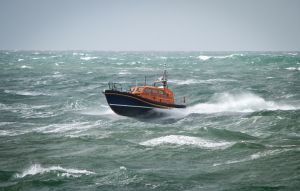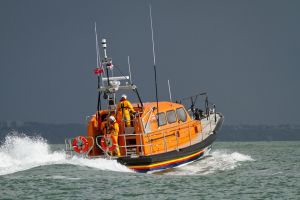Exmouth will be one of the first lifeboat stations in the country to receive an innovative new class of RNLI lifeboat, the Shannon.
The new £1.5m lifeboat will replace Exmouth’s current RNLI Mersey class lifeboat, Margaret Jean, when she completes her operational time in Devon in around 12 months time. The cost of the new lifeboat will be met by a legacy but an appeal is starting today (Monday 15 October) to help fund the new launching and recovery vehicle that is essential to move the lifeboat to and from the sea.
Tim Mock, Exmouth RNLI Coxswain says everyone at the lifeboat station is very excited:
‘We’re all delighted and extremely honoured that we are to receive one of the first of the new Shannon class of lifeboats. We’ve already hosted trials of both the Shannon class lifeboat and the new launch and recovery vehicle that has been developed in conjunction with it. The volunteer crew here had the opportunity to experience its water jet propulsion system, and now we can’t wait to see the Shannon coming to the station. We’re sure her capabilities will enhance our ability to save lives at sea as the Shannon can reach 25 knots, which will save precious time during a rescue, almost 50% faster than our current lifeboat.’
The new lifeboat will be funded by a generous legacy from Mrs Joan Welburn who lived in Sidmouth and passed away in March 2009. After bequests to family, friends and other charities, the RNLI were bequeathed her whole residuary estate. Mrs Welburn requested that the capital from her estate was used for the provision of a lifeboat, named The R & J Welburn as a memorial to her late husband Raymond, who was related to Captain Michael Hansley Welburn, Master of the lifeboat at Spurn Point. Captain Welburn died in 1853 at the age of 37 and his name was recently added to the RNLI’s Memorial ‘having lost his life due to exposure to cold while endeavouring to save life and property’.
The Shannon will come with a new launch and recovery vehicle (L&RV), designed in conjunction with Supacat Ltd of Devon. It can operate in many different beach and sea conditions and allows a faster and highly automated launch and recovery time. This new system will cost £1 million and today the fundraising team at Exmouth RNLI is launching an appeal to raise a proportion of the cost.
Don Hodgkinson, Chair of the RNLI Fundraising Guild at Exmouth, says:
‘We very much want the community to feel they are playing a part in this new chapter for Exmouth RNLI and this appeal will provide them with the opportunity to help. We aim to raise a proportion of the cost for the new launch and recovery vehicle and will be busy organising fundraising events from now on. The people of Exmouth were absolutely superb in their support for our appeal to fund our lifeboat station and recently our new lifejackets, now we hope they will stand by us as we face the challenge of raising funds for this very exciting new vehicle that will ensure an even quicker response time for those who need saving at sea.’
The Shannon has been designed in-house by RNLI naval architects who have harnessed cutting-edge technology to ensure the new lifeboat meets the demands of a 21st century rescue service and to allow the charity’s volunteer crew to do their lifesaving work as safely as possible in all weather conditions.
The new lifeboat features twin water jets instead of conventional propellers, allowing her to operate in shallow waters and be highly manoeuvrable, giving the crew greater control when alongside other craft and when in confined waters. The water jets also reduce the risk of damage to the lifeboat during launch and recovery, or when intentionally beached. She will be the first RNLI all-weather lifeboat to run on water jets instead of propellers.

The Shannon’s seats are designed to protect the crew members’ spines as much as possible from the forces of the sea in rough weather. Additionally the Shannon incorporates SIMS (System and Information Management System) which allows the crew to monitor the lifeboat from the safety of their seats, again reducing the likelihood of injury to the volunteer crew members during search and rescue operations.
With a top speed of 25 knots, the Shannon is faster than her predecessor the Mersey, which has a top speed of 17 knots. The introduction of the Shannon will be the first step in enabling the RNLI to fulfil its commitment to ensure that all its operational all-weather lifeboats have a top speed of 25 knots – a crucial factor when lives are at risk.
Like all RNLI all-weather lifeboats, the Shannon is self-righting and it will return to an upright position in the event of a capsize during extreme weather or sea conditions.


Leave a Reply